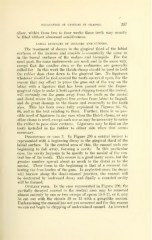Page 459 - My FlipBook
P. 459
EXCAVATION OF CAVITIES BY CLASSES. 207
allow, within from two to four weeks these teeth may usually
be filled without abnormal sensitiveness.
LABIAL SURFACES OF INCISORS AND CrSPIDS.
The treatment of decays in the gingival third of the labial
surfaces of the incisors and cuspids is essentially the same as
in the buccal surfaces of the molars and bicuspids. For the
most part, the same instruments are used, and in the same way,
except that the smaller sizes or the ordinaries are generally
called for. In this work the Hatch clamp should be used to hold
the rubber dam close down to the gingival line. No ligatures
whatever should be tied around the tooth operated upon, for the
reason that any effort to press the gum out of the way on the
labial with a ligature that has been passed over the linguo-
gingival ridge to make it hold against slipping toward the incisal,
will certainly cut the gums away from the tooth on the mesial
and distal where the gingival line arches from labial to lingual,
and do great damage to the tissue and eventually to the teeth
also. This has been more fully explained in Figures 8-i, 85,
86, and in the text relating to them. Further, there is no pos-
sible need of ligatures in any case when the Hatch clamp, or any
other clamp is used, except such use as may be necessary to cause
the rubber to pass close contacts. Ligatures may be tied on the
teeth included in the rubber to either side when that seems
necessary.
Description of case 3. In Figure 290 a central incisor is
represented with a beginning decay in the gingival third of the
labial surface. In the central area of this, the enamel rods are
beginning to fall away, forming a cavity. In this particular
case, the cavity happens to be mostly to the mesial of the cen-
tral line of the tooth. This occurs in a good many cases, but the
greater number spread about as much to the distal as to the
mesial. Their form in the beginning is that of a crescent fol-
lowing the free border of the giuu. In neglected cases the decay
will burrow along the dento-enamel junction, the enamel will
be destroyed by backward decay and finally a rounded cavity
vsdll be formed.
Outline form. In the case represented in Figure 290, the
partially decayed enamel in the central area may be removed
almost entirely by one or two sweeps of spoon 15-8-12, or it may
be cut out with the chisels 10 or 15 with a gougelike motion.
Undermining the enamel has not yet occurred and for this reason
we can not begin by chipping of undermined enamel. An inverted


